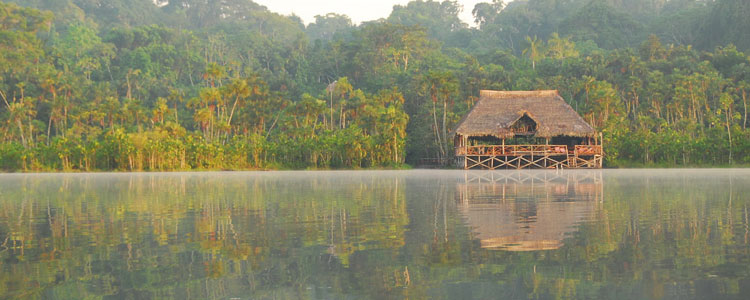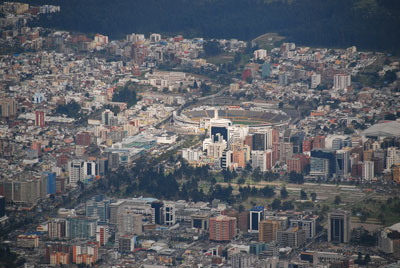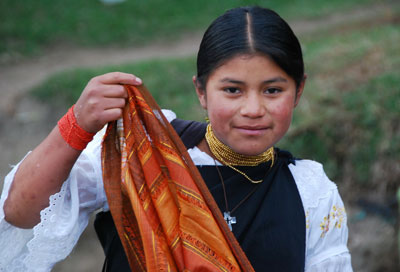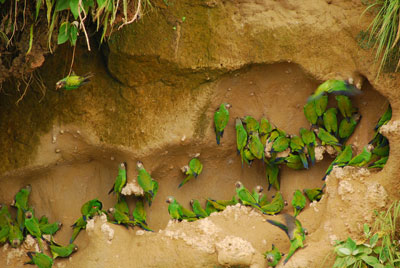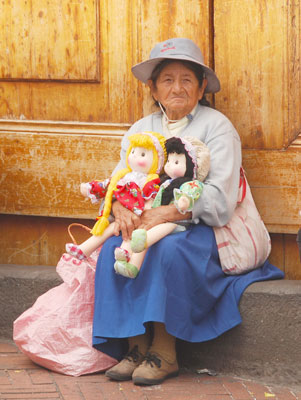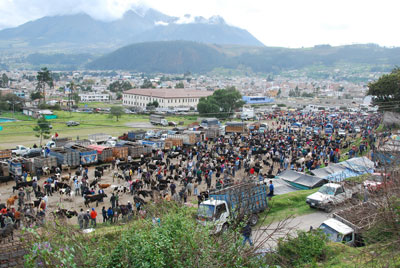Snapshots of Ecuador – a photo tour
by Ed Kinney, Roanoake, VA
For years I thought most travelers went to Ecuador only to visit its Galápagos Islands, but a 10-day tour of Ecuador proper in January 2010 changed my perspective. I found a nation of diverse and wonderful cultures, beautiful landscapes and colorful wildlife.
Planning the trip
Having spent the majority of my travel time in the Middle and Far East, I was looking for a different venue for my latest trip. While reviewing travel brochures, I read of an Exploritas (Elderhostel) tour entitled “Photographing the Colors of Ecuador,” offered by Holbrook Travel (Gainesville, FL; 800/451-7111). The schedule was a perfect fit, as I could rendezvous with my sister in Atlanta, Georgia, then we both would continue from there on a nonstop Delta Air Lines flight to Quito, the capital of Ecuador.
Much to our surprise and pleasure, we learned there would be only five of us on this tour, accompanied by Ecuadorans Paul Narvaez (group leader), Tarik Nuñez (photo leader) and Gustavo Tapia (driver). Having such a small group permitted more individual attention, and it enabled us to stop frequently for photos, etc.
Quito
A city of 2.5 million, Quito is a mix of colonial architecture and brash modern buildings located within a narrow valley at 9,350 feet in elevation. In 1978, Quito became the first city in the world to receive World Heritage status from UNESCO.
To appreciate Quito’s panorama, we rode the teleférico (cable car) to nearly the top of Pichincha Volcano. Unless already acclimated, visitors require frequent rest breaks to avoid mountain sickness at this 13,645-foot elevation.
During our one full day in the city — just enough time to appreciate the capital, photography-wise — we wandered mostly in and around the heart of colonial Quito: the Plaza Grande (also known as Plaza de la Independencia). The area was clean, with minimal hawking of goods and no graffiti or begging. I enjoyed photographing the Plaza de la Independencia, including the presidential palace, and the Plaza San Francisco.
I highly recommend a visit to La Compañía, though photography isn’t permitted there. This church is reportedly the most beautiful and ornate in the Americas. It is said that seven tons of gold are imbedded in the ceiling, walls and altars.
I’d also recommend a walk along one of Quito’s best-preserved colonial streets, Calle Juan de Dios Morales, or La Ronda. We took a step back in time there, visualizing evening rondas (serenades), with musicians wandering this narrow street lined with colorfully painted balconies and quaint shops.
On to Coca
The next morning we took a 45-minute flight to Puerto Francisco de Orellana (aka Coca), a town of 25,000. At its airport, we climbed on board an ancient covered truck with wooden benches and rode several miles to the Napo River, a tributary of the Amazon. We then boarded a canvas-covered boat for the two-hour ride to the entrance of Sacha Lodge.
From there we walked about a mile on a dirt path to a lagoon, where we were transferred by canoe to the lodge itself, our home for three days.
I highlight these details, as there are no roads to Sacha, located in an environmentally sensitive area. All supplies must be transported in and all waste taken out via the Napo River. This strong environmental protection further enhanced my admiration for the Sacha Lodge complex and the luxury it provides its guests.
Each cabin had hot showers and electricity, and I shouldn’t forget the fantastic food nor our accompanying naturalist, Lars, and our local native guide, Eresto. Because of them, we were able to appreciate some of Sacha’s 4,500 acres of terra firme forests, swamps, black-water flooded forests and river islands.
Outdoor adventure
Daily we took one and often two canoe rides deep into the surrounding rainforest, following water trails only Eresto knew. During these rides, Lars quietly identified plants and wildlife, his voice barely heard above the muffled sounds of Eresto’s paddle.
The rides were especially exciting at dawn and late in the afternoon, when the birds were most active. One evening we ventured into the lodge’s pitch-dark lagoon using a flashlight to look for caimans. Periodically, the reflected glow of their eyes could be seen and Eresto would silently glide our canoe close so we could photograph them. Lars’ flashlight beam seemed to hypnotize them.
In addition to several exploratory hikes within Sacha’s terra firme forests, two other nature visits stood out. Sacha has an outstanding enclosed butterfly farm where as many as 24 species are reared from eggs to pupae for overseas sales. The colors of these butterflies were magnificent as they fluttered around us.
The other visit included a two-hour boat ride, again on the Napo River, to observe several varieties of parrots. Parrots come to hillside clay licks every couple of days to neutralize their acidic diet; otherwise, they might die. It was quite a scene, the colorful parrots pushing and shoving for the best spot.
Otavalo
Upon returning to Quito, we drove north about 90 minutes to the modestly sized city of Otavalo, located in a wide scenic valley surrounded by three separate mountain peaks. Our home for the next three nights would be Hacíenda Cusín in the nearby village of San Pablo del Logo.
The hacienda, a restored 17th-century Andean estate, is now one of the most famous and luxurious country inns in all of South America.
I was impressed by its total ambience. Nightly, following a wonderful dinner, I’d find a glowing fire in my bedroom’s hearth. Though practically on the equator, the hacienda is at an elevation of 8,500 feet and nights were chilly.
To market
Otavalo is best known for its Saturday markets, probably the oldest of all Andean markets, where thousands gather to buy, sell or just observe. There are several market areas in Otavalo, and our first venture was to visit the animal market.
Arriving at 6:30 a.m., we found the area packed with Otavaleños and their livestock. The haggling had already begun.
Although there were a few other tourists at the market, we were basically ignored, permitting us to wander about with our cameras.
By 10 a.m. we were famished, so we drove to the nearby Las Palmeras Inn for breakfast. (Much later we returned there for lunch.)
After breakfast we continued our market explorations, viewing first the food market where locals buy and sell food and small animals. Then we visited the immense Plaza de Ponchos, the granddad, in size and scope, of all Andean markets. This textile market features established areas where locals barter for basic necessities and crafts. It offers a trove of opportunities for photographers.
Occasionally during our visit, an Otavaleño would quietly tap me on the arm, wanting to know if I wished to buy a craft item. Otherwise, I was left to do as I pleased, which was to take photos.
Village visits
Late that same afternoon we drove to Peguche, one of the more successful indigenous villages near Otavalo. Homes and shops around the village square specialized in rugs, blankets and tapestries.
During our last full day at the hacienda, we took an excursion to Mascarilla, in the Chota Valley. The roughly 1,000 inhabitants of Mascarilla are Afro-Ecuadorans, descendants of black slaves brought there centuries ago by the Spanish. In the more recent past, Mascarilla’s economy depended on papaya trees, but a disease decimated the trees a decade ago. Fortunately, an Italian foundation taught locals how to make African-style clay masks and dolls, creating a new industry while reconnecting them with their African roots. Mascarilla also functions as a tourist village.
Papallacta & Antisana Reserve
From the Hacíenda Cusín we drove to Papallacta, located about 40 miles east of Quito. The high point of our drive was visiting the beautiful Hacienda La Compañía estate, located on 20 hectares of Cayambe Valley land. After the owner and hostess, Maria Gloria Vallejo, and her staff served us a delicious lunch, we were allowed to photograph the interior of this beautifully decorated estate.
Then Maria’s husband, Francisco, gave us an hour-long tour of their rose plantation. Rosadex, a socially and environmentally responsible Ecuadoran company, air freights 30 varieties of roses to US and European markets. Selected roses are cut and protectively packaged, then shipped that very same evening on flights, arriving in the US and beyond early the next morning for sales. Roses are Ecuador’s fourth-largest export.
At dusk we arrived at Termas de Papallacta, our lodging for the next two nights. Leaving the main road to Papallacta, we bumped along a dirt road for three miles to the finest developed hot springs in Ecuador. Situated at 10,800 feet in a steep Andean valley, the steaming hot springs, combined with dripping low clouds, provided a unique environment.
Termas’ lodging and food were comparable with those of our prior accommodations, but here we had an opportunity to soothe our tired limbs in the lodge’s hot spring waters after days of exciting touring.
Rising early the next morning, we drove higher and higher under blue skies into the Antisana Ecological Reserve. These environs were completely different from those on our visits to the Amazon rainforests and indigenous villages in the Otavalo area.
The Antisana Reserve was established in 1993, when Ecuador set aside more than 300,000 acres of its Andes. This 14,000-foot treeless high plain is guarded under the watchful presence of Antisana, a snowcapped volcanic mountain. Though desolate, this area was hauntingly beautiful and is home to more than 50 species of birds. The only downer experienced — we didn’t see any of the few remaining endangered condors that live there.
For lunch we stopped at an Antisana farm, the only farm home I saw during our visit to this reserve.
Returning to Quito
During our last morning, before driving back to Quito, we made one last photo stop, at the Guango Lodge in Papallacta. The environs of this lodge are home to hundreds of hummingbirds. The only problem I had was trying to decide which hummingbird to photograph! They were in constant flux, pushing and shoving one another at the feeders. I just placed a feeder in a photographic spot and waited a few moments and the “models” appeared.
Our farewell dinner, at the Quito Sheraton Hotel, provided us with an opportunity to discuss wonderful memories of a tour that ended way too soon. We were also given a CD with a collection of what our professional photographer, Tarik Nuñez, considered to be the best of our combined photos of Ecuador — a nice farewell gift from our wonderful tour leaders.
The details
The tour name, “Photographing the Colors of Ecuador: Nature, People and Culture,” certainly summarizes this 11-night adventure, but one does not have to be a serious photographer to fully enjoy this tour. My sister, using a point-and-shoot camera, was able to take wonderful photos highlighting the many cultures of Ecuador.
The tour price was $4,085 per person, double occupancy, which included all meals and airfare from Miami. I also paid a single supplement of $875.
For photography enthusiasts, I’d recommend an SLR camera with at least an 18-200mm or an 18-300mm zoom lens with vibration reduction for wildlife shots from canoes and candid shots in market areas. No one on my tour effectively used a tripod.
Ecuador is relatively unique, as it uses US paper currency for all transactions, having converted in 2000.
Though Ecuador isn’t noted for its gourmet food, I was impressed with the quality we experienced throughout our trip, especially at the hacienda and Sacha as well as at our Sheraton hotel in Quito. In the remote areas we visited, the food was more culturally traditional and included high-carbohydrate foods such as rice, corn and potatoes in addition to wheat and barley. Large bowls of hot soup made with potatoes and grains were normally served with lunch and dinner.
I found the food less spicy than most Mexican cuisine.
Regarding health issues, we were advised that a yellow fever inoculation was required to enter Ecuador, though my International Certificate of Vaccination was never checked. Yellow fever inoculations are good for 10 years.
I didn’t take a malaria prophylaxis. Sacha representatives stated that most of the mosquitoes in their area had been eradicated.
Exploritas (Boston, MA; 800/454-5768) assigns a number-5 activity rating, its highest, to this tour, indicating that it is one of the most strenuous offered. This tour includes considerable walking over uneven paths with severe elevation changes, in addition to frequent long days with 5:30 a.m. wake-ups.
Those seeking specific travel information regarding this tour may also wish to contact tour director Paul Narvaez (e-mail paul@ecuadorlifetime.com).

